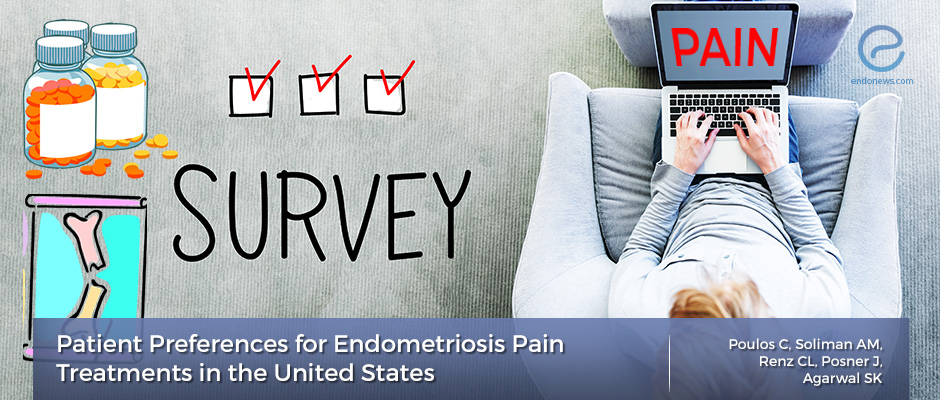Patients preferences for the treatment of endometriosis-associated pain
Sep 10, 2019
Women with endometriosis prefer treatment options for the improvement of endometriosis-associated pain, ignoring treatment-related risks including hot flushes and bone fracture risks.
Key Points
Highlights:
- Endometriosis-associated pain is the most important symptom in women with endometriosis that they want to treat accepting any risks in exchange.
Importance:
- Endometriosis-associated pain consisting dysmenorrhea, non-menstrual pelvic pain and dyspareunia can be reduced by treatment alternatives in spite of pregnancy-related problems, hot flushes, and bone fracture risks.
What’s done here?
- An online discrete choice experiment survey was applied to women with a self-reported physician diagnosis of endometriosis and moderate to severe dysmenorrhea through two sources.
- Questions about the treatment experience, clinical and demographic characteristics of the patients were included in this survey.
- Women, aged 18 - 45 years or older with a self-reported physician diagnosis of endometriosis, and moderate to severe dysmenorrhea and non-menstrual pelvic pain were included.
Key results:
- A total of 250 patients were included in the study who completed the survey.
- Diagnosis of endometriosis took up to a mean of 11.4±8.3 years. Mean age of diagnosis was 22.3±8.9 years old in these women.
- 118 respondents (47.2%) suffered from personal or family bone problems, whereas 128 respondents (51.2%) reported moderate to severe hot flashes, 84 women (33.6%) were interested in becoming pregnant.
- Endometriosis was diagnosed using laparoscopy or laparotomy in 181 women (72.4%) among respondents.
- There was no difference between patients regarding their interest in becoming pregnant, a personal or family history of bone problems, age, and experience of opioid use for endometriosis-associated pain.
- As a result of the survey, women demanded improvement in dysmenorrhea accepting a 9% additional pregnancy-related risks and a 26% bone fracture risks.
Limitations
- The study did not represent the whole endometriosis population. Women with a self-reported physician diagnosis of endometriosis were included, laparoscopy or laparotomy diagnosis was performed in approximately 75% of respondents.
- DCE studies may differ in terms of actual preferences for treatment choices. Also, accepting bone fracture risks may be due to the beliefs about the ability to reduce the risk.
Lay Summary
Endometriosis is defined as the location of endometrial stroma and glands outside the uterine cavity. The most common presenting complaints are mainly dysmenorrhea, dyspareunia, chronic pelvic pain, and infertility, most of which relate to the menstrual period.
Those women affected by endometriosis demand therapy for the symptoms of endometriosis, notably dysmenorrhea and non-menstrual pelvic pain. Despite extensive research, the optimal management of endometriosis still remains unclear. Non-steroidal anti-inflammatory drugs, narcotics, hormonal contraceptives, progestin therapy, gonadotropin-releasing hormone (GnRH) analogs (eg, leuprolide, goserelin, and nafarelin), and danazol can be preferred as medical treatment options, some of which are approved by the US Food and Drug Administration (FDA) for the treatment of endometriosis.
Current medical and surgical treatment options have several limitations including the side effects, costs, risk of recurrence, effects on conception capability. Poulos et al, a group of scientists from the United States, published a study titled as “Patient Preferences for Endometriosis Pain Treatments in the United States” in the journal named as Value Health.
The authors aimed to investigate which drug is more preferable by patients for endometriosis-associated pain. For this purpose, they conducted an online discrete choice experiment survey including questions about the treatment experience, clinical and demographic characteristics of the patients to women with a self-reported physician diagnosis of endometriosis and moderate to severe dysmenorrhea and non-menstrual pelvic pain. They recruited the patients through two sources: The Endometriosis Association between April and May 2017 and SSI in November 2017.
Despite several limitations of this study, the authors summarized that women with endometriosis preferred the medical therapy alternatives for endometriosis-associated pain accepting all risks including pregnancy-related problems, hot flushes, and bone fractures.
“Improvements in dyspareunia, NMPP, and dysmenorrhea were also important attributes, whereas the risk of bone fracture was the least important attribute,” they added.
Research Source: https://www.ncbi.nlm.nih.gov/pubmed/31198191
endometriosis dysmenorrhea dyspareunia non-menstrual pelvic pain (NMPP) hot flushes bone fracture discrete choice experiment survey (DCE)

